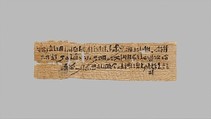Letter written in hieratic script on papyrus
New Kingdom
In the letter below - written on papyrus—a man named Tet tells “his lord” Djehuti in rather forthright terms to rectify a bad situation he had caused by insulting a dependent of the high priest of Heliopolis. The letter was folded and addressed to the recipient on the back of the sheet.
Sheets of papyrus - Egypt's primary writing surface - were made from long, thin strips of papyrus fibers, which were cut from the pith of the papyrus stalk once the tough outer rind had been removed. Strips were laid down side by side to form a base layer, and a second layer of strips was placed perpendicularly across the top. The two layers were then pressed or pounded together and allowed to dry. Longer scrolls were produced by gluing together the ends of several sheets. The papyrus scroll was the "book" of Antiquity until parchment (from animal skins) started to become a rival from the 2nd century B. C. and codices (books in the modern sense) gradually replaced the scroll during the 4th -7th century A.D.
Due to rights restrictions, this image cannot be enlarged, viewed at full screen, or downloaded.


